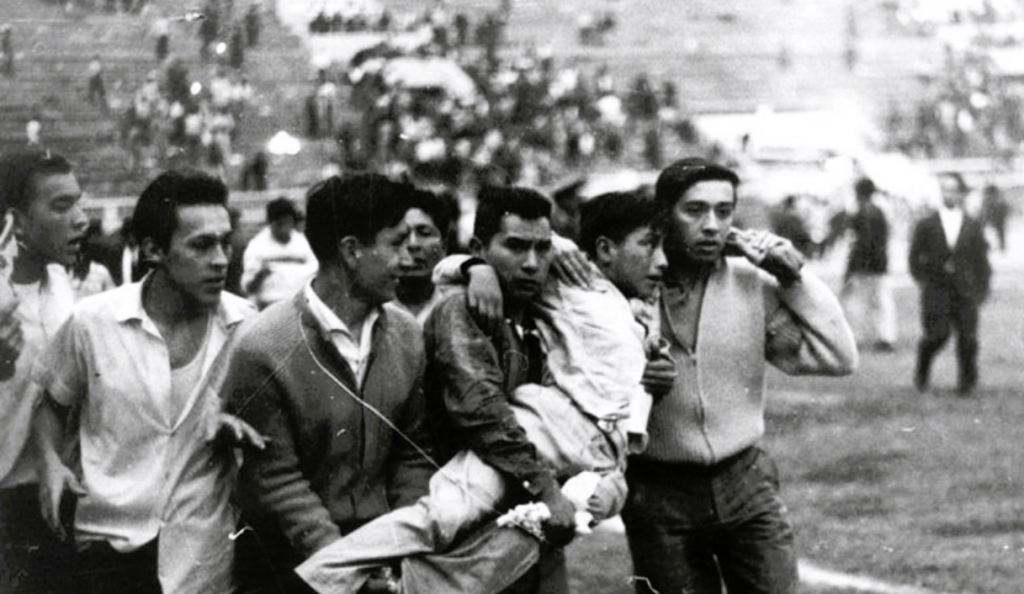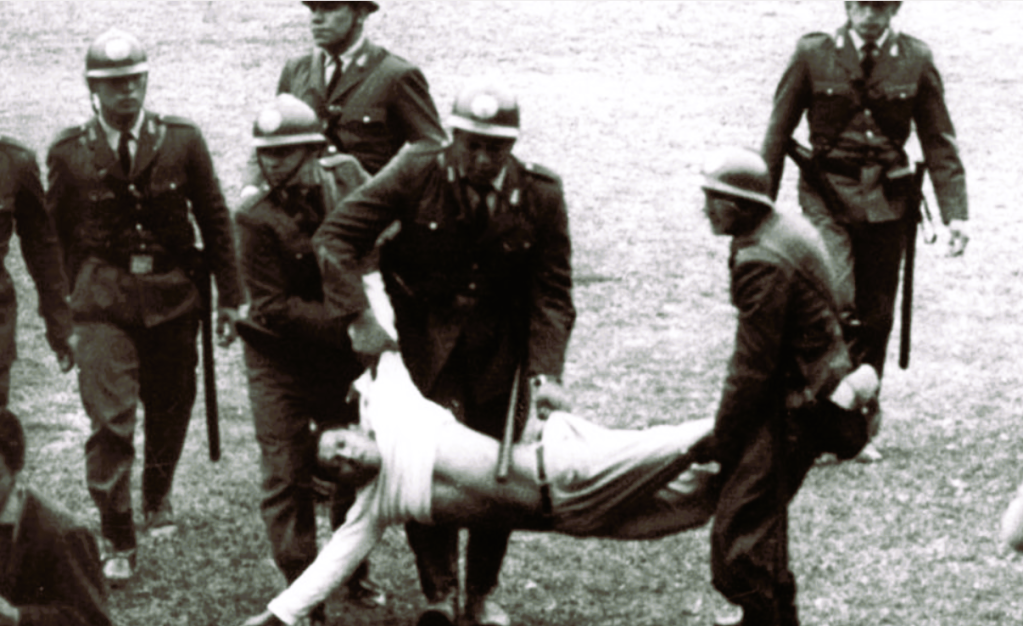
Dutch football manager Rinus Michels once said, “Football is war.”
The Estadio Nacional disaster was a tragic event that took place on May 24, 1964, at the Estadio Nacional in Lima, Peru. It is still the deadliest football disaster in history. Here are the key details of the disaster:
- Event: The disaster occurred during an Olympic qualifying match between Peru and Argentina. The match was crucial, and tensions were high as both teams were vying for a spot in the Tokyo Olympics.
- Incident: The tragedy began when the referee disallowed a late goal scored by Peru, which would have tied the game. The controversial decision led to outrage among the Peruvian fans.
- Chaos: Fans began to invade the pitch in protest of the referee’s decision. The police responded with tear gas to control the crowd, which led to panic and a mass stampede.
- Fatalities: As the panicked fans attempted to escape the tear gas, they rushed towards the exits. Unfortunately, many of the exits were locked, causing a deadly crush. Official reports state that 328 people died, and over 500 were injured in the ensuing chaos.
On 24 May 1964, Peru hosted Argentina at the Estadio Nacional in Lima. The game, in the qualifying round for the Tokyo Olympics’ football tournament, was seen as vital for Peru, holding second qualifying place in the CONMEBOL table, which would face a tough match against Brazil in their final game. The match attracted a crowd of 53,000 to the stadium, a little over 5% of Lima’s population at the time.

With Argentina leading 1–0 and six minutes of normal time remaining, a would-be equalising goal by Peru was disallowed by Uruguayan referee Ángel Eduardo Pazos. This decision infuriated the home fans and triggered a pitch invasion. Peruvian police fired tear gas canisters into the northern grandstand to prevent further fans from invading the field of play. This caused panic and an attempt at a mass exodus to avoid the tear gas.
In quick succession, two spectators entered the field of play. The first was a bouncer known as Bomba, who tried to hit the referee before being both stopped by police and manhandled off the field.

The second, Edilberto Cuenca, then suffered a brutal assault.
This is how it was reported in the New York Times on May 25,1964.
“LIMA, Peru, May 24 — At least 300 persons were killed today when an unpopular decision by a referee at a soccer game touched off a riot at National Stadium.
Five hundred others were injured.
The Government proclaimed a state of emergency throughout Peru. It said constitutional guarantees would be suspended for 30 days in order to investigate the tragedy.
The angry, screaming mob surged out of bleacher seats, smashed every window in the stadium, and then overflowed into nearby streets, overturning cars, sacking stores, and setting buildings afire. Most of those killed were trampled to death.
Policemen on horseback hurled tear gas bombs and released dogs on the crowd of about 45,000. At least four of the dead were shot by police bullets.
The game was between teams from Argentina and Peru competing for a chance to play in the Olympic Games in Tokyo.
With the score 1—0 in favor of Argentina and less than two minutes to play, a Peruvian wingman booted a goal, but the referee, R. Angel Pazos of Uruguay, nullified it because of Peru’s rough play.
While the crowd was still booing, two spectators leaped over a barrier and attacked the referee. They were quickly arrested by a total of 40 policemen.
The crowd roared in anger, and Mr. Pazos ordered the game suspended because of the tense situation and the lack of adequate police protection on the field.
When the decision was announced, the crowd screamed in disapproval. Mr. Pazos and the players ran for a ramp under the stadium as spectators jumped over the wire fences surrounding the field.
My Son Was in a Psychiatric Hospital. Why Was I Celebrating?
The referee and the players escaped with their lives only because the small police detail at the stadium rushed them into a steel‐doored locker room’ beneath the stadium and then piled them onto buses that took them to a remote part of the city.
Mounted policemen attempted to direct the crowd toward the exits, often charging into rioters to disperse them. Other policemen fired shots in the air and threw tear gas grenades. These tactics seemed to increase the panic.
Rioters hurled stones and bottles at the police, overturn‑ ing benches, and setting a part of the stadium on fire.
Many of the exits to the stadium were locked, and bystanders were trampled or asphyxiated as people rushed toward open exit gates to avoid the tear gas and fires.
Gangs of young toughs swarmed around the stadium and rifled watches, rings, and wallets from the dead and injured.

In the heart of Lima, a bus, several cars, two office buildings, and a brick factory were set afire. But firemen already at the scene were able to extinguish the blazes quickly, and fire damage was said to be light.
The dead and injured were transported to hospitals in ambulances, police cars, and commandeered private vehicles. Crowds formed outside, hospitals and temporary morgues chanting “Revenge!” and “Down with the police!”
One portion of the mob marched on the National Palace to seek an audience with President Fernando Belaunde Terry to protest police brutality and to seek his intervention in having the soccer match officially declared a tie.
Fatalities resulting from riots or panic at large gatherings have not been unusual in recent years, but rarely have they been on the scale of the riot in Peru.
The largest mass disaster caused by panic in recent years took place in India in 1954 when 350- persons were reported to have been killed during a Hindu religious rite on the banks of a sacred river.
Last year in Italy, one spectator was killed, and 89 were injured after two soccer games played in Naples and Salerno. Riots at Italian sporting events are not unusual, however, although fatalities. are rare.
From time to time, riots have broken out in this country at sporting events. At Roosevelt Raceway here last year, for example, disgruntled horse players battled the police and attempted to set fire to the grandstand. Fifteen persons were injured, and one man died of a heart attack.”

There was one disaster with possibly more fatalities. In 1982, an estimated 340 people died at a match in Moscow when a late goal caused fans who had exited the game to attempt to return suddenly. Meanwhile, police were forcing people to exit; those caught in the middle were crushed. However, some sources put the number of fatalities at 65. The exact number was never verified.
Sources
https://www.bbc.com/news/magazine-27540668
https://www.dw.com/en/the-luzhniki-stadiums-forgotten-disaster/a-44654245